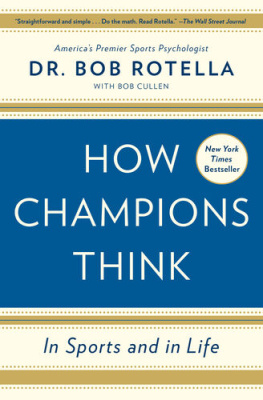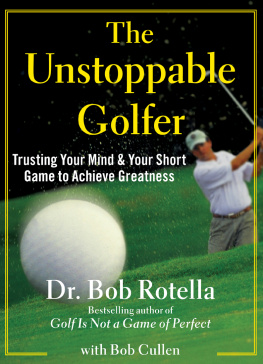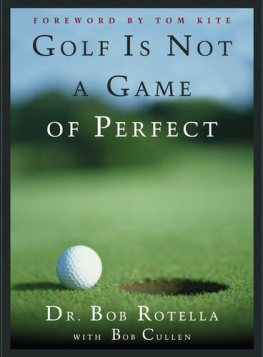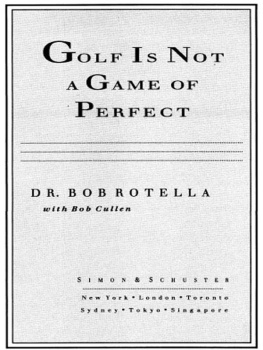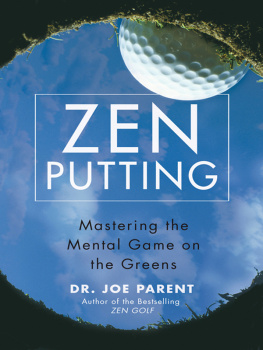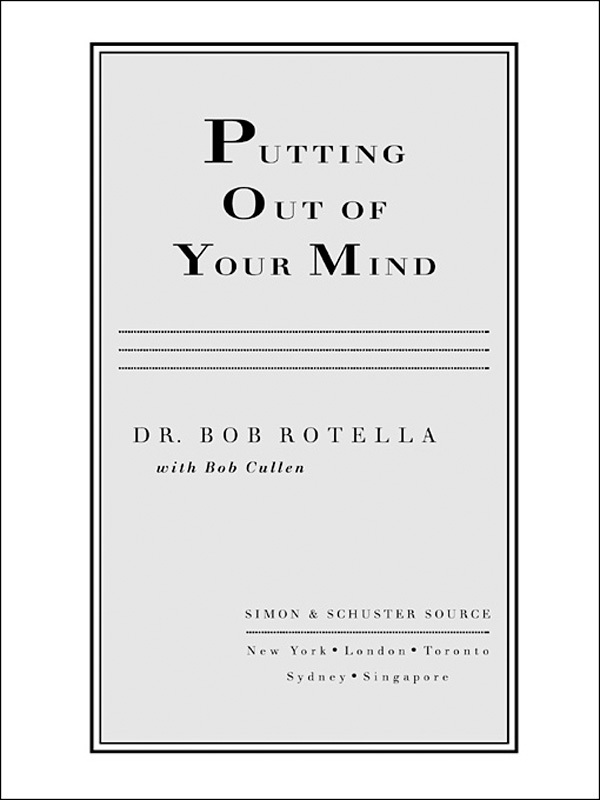Introduction
by Brad Faxon
WHEN I FIRST ENCOUNTERED DR. BOB ROTELLA, GOLFERS SPOKE OF psychologists in whispers, if they spoke about them at all.
In 1979, my first year at Furman University, one of my new classmates was a tennis player from Charlottesville, Virginia, named Frank Taylor. Frank had a book on athletic motivation, one of the first published works that made an effort to apply the science of psychology to sports. It was by two University of Virginia faculty members, Dr. Linda Bunker and Dr. Bob Rotella. I was intrigued. I read it and it helped me. I had a good career at Furman, becoming an All-American and a member of the Walker Cup team.
In 1983, I turned pro. On the PGA Tour in those days, players who talked to psychologists still didnt advertise the fact. But one day I played a practice round with Denis Watson. Denis, at the time, had risen suddenly out of the pack of Tour players to become one of the leading money winners. As we walked off the 18th green, I asked him what was behind his rapid improvement. He looked at me almost shyly. He confided that he had gone to see a sports psychologist in Virginia who had taught him better approaches to the mental side of the game.
Bob Rotella? I asked him.
Denis was startled that I knew the name. I told him I had read one of Rotellas books. I asked him about what Rotella had said that had helped him so much.
Everything, Denis replied.
That was enough to persuade me to go to Charlottesville myself. Bob and I hit it off right away. We have been working together ever since, and Bob has become more than a consultant to me. Hes become a friend and an important person in my life. Bobs ideas did not affect my game as suddenly or dramatically as they did Deniss. But they helped me, particularly in putting.
In seventeen years, Bob has never tried to change my putting stroke. To me, that makes sense. Golf has seen a tremendous variety of putting strokes and styles. If I close my eyes, I can see pictures of the great players puttingthe crouching Nicklaus, the knock-kneed Palmer, the upright and flowing Crenshaw, and the determined and robotic Watson. Theyre all different. Tiger Woods, the best in the game right now, has a classic stroke. Tiger looks perfect standing over his putter. But there have also been greats such as Isao Aoki, Bobby Locke, and Billy Casper, with peculiar styles that few would dare emulate.
What Bob Rotella knows is that the secret to great putting is not in the stroke. Its in the mind. When you putt, your state of mind is more important than your mechanics.
Some people have a hard time understanding this. Because I am usually among the leaders in the Tours putting statistics, Im often asked if theres a secret to great putting. I usually reply that if there were a secret, Id bottle it and sell it. Id make a lot of money. Id make a lot of golfers better putters and happier people.
But while there is no secret, there is a set of ideasa way of thinkingthat can help anyone become a better putter, perhaps even a great one. Thats what youre going to find in this book. The good news is that these ideas make sense and they can be learned. I say this because I learned them and they became the foundation of my putting game. If I learned them, you can learn them, too. Maybe youve tried to improve your putting and havent been successful. That doesnt mean you cant putt. It just means youve been going about it in the wrong way. The ability to putt well is inside you. You just have to get out of your own way and use it.
Youre going to encounter concepts in these pages that may be new to you, concepts like trusting yourself, letting go, freeing it up, and loving the challenge of putting. Youre going to learn how to develop a putting routine that works under pressure. Youre going to find out what it feels like to love putting and to love making putts. Youre going to learn some practice games and routines that I and other players use on the Tour. Youre going to learn to understand the paradox that is at the heart of putting success: You make more putts when you dont care if you miss.
Judging by the way my pro-am partners generally act on the greens, these ideas may well be radically different from the thoughts you have now. A lot of the amateurs I see dont know how to trust themselves, dont know how to let go. They loathe and fear putting. They try very hard and they care desperately whether the ball goes in the hole. Not coincidentally, they dont putt very well.
If this sounds familiar to you, prepare for a change. If you can read, absorb, and adopt the ideas Bob Rotella teaches, youll do more than sink a few putts. Youll enhance the pleasure you take from the game. Youll feel that a weight has been lifted from your shoulders.
Bob Rotellas ideas on putting are simple, but that doesnt mean theyre easy to assimilate and follow. They may contradict attitudes youve carried around for most of your life. People often look at me in disbelief when I tell them I dont care that much if I miss a putt, that the result isnt as important to me as where my mind was when I stood over the ball. They dont understand what Ive learned from Bob: If I can consistently achieve the right state of mind, I will consistently hole more putts.
Of course, if putting in the right frame of mind were easy, everyone would do it. And then you wouldnt get the competitive advantage youre going to have when you finish this book.


